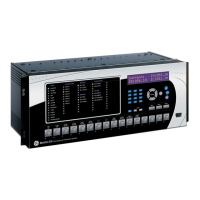9-4 D30 LINE DISTANCE PROTECTION SYSTEM – INSTRUCTION MANUAL
DISTANCE ELEMENTS CHAPTER 9: THEORY OF OPERATION
9
• BC phase element — (I
B
– I
C
) × Z – (V
B
– V
C
) and (I
B
– I
C
) × Z
• CA phase element — (I
C
– I
A
) × Z – (V
C
– V
A
) and (I
C
– I
A
) × Z
• A ground element — I
A
× Z + I_0 × K0 × Z + I
G
× K0M × Z – V
A
and (j × I_0 or j × I_2A) × e
jΘ
• B ground element — I
B
× Z + I_0 × K0 × Z + I
G
× K0M × Z – V
B
and (j × I_0 or j × I_2B) × e
jΘ
• C ground element — I
C
× Z + I_0 × K0 × Z + I
G
× K0M × Z – V
C
and (j × I_0 or j × I_2C) × e
jΘ
The ground elements are polarized from either zero-sequence or negative-sequence current as per user-settings to
maximize performance in non-homogenous systems. The polarizing current is additionally shifted by the user-selectable
non-homogeneity correction angle.
9.1.3.6 Reverse quadrilateral reactance characteristic for non-directional applications
The reverse quadrilateral reactance characteristic is achieved by checking the angle between
• AB phase element — (I
A
– I
B
) × Z
REV
– (V
A
– V
B
) and (I
A
– I
B
) × Z
REV
• BC phase element — (I
B
– I
C
) × Z
REV
– (V
B
– V
C
) and (I
B
– I
C
) × Z
REV
• CA phase element — (I
C
– I
A
) × Z
REV
– (V
C
– V
A
) and (I
C
– I
A
) × Z
REV
• A ground element — (I
A
× Z
REV
+ I_0 × K0 × Z
REV
+ I
G
× K0M × Z
REV
– V
A
and (j × I_0 or j × I_2A) × e
j(180 + Θ)
• B ground element — (I
B
× Z
REV
+ I_0 × K0 × Z
REV
+ I
G
× K0M × Z
REV
– V
B
and (j × I_0 or j × I_2B) × e
j(180 + Θ)
• C ground element — (I
C
× Z
REV
+ I_0 × K0 × Z
REV
+ I
G
× K0M × Z
REV
– V
C
and (j × I_0 or j × I_2C) × e
j(180 + Θ)
The ground elements are polarized from either zero-sequence or negative-sequence current as per user-settings to
maximize performance in non-homogenous systems. The polarizing current is additionally shifted by the user-selectable
non-homogeneity correction angle.
9.1.3.7 Directional characteristic
The directional characteristic is achieved by checking the angle between
• AB phase element — (I
A
– I
B
) × Z
D
and (V
A
– V
B
)_1M
• BC phase element — (I
B
– I
C
) × Z
D
and (V
B
– V
C
)_1M
• CA phase element — (I
C
– I
A
) × Z
D
and (V
C
– V
A
)_1M
• A ground element — I_0 × Z
D
and V
A
_1M
I
A
_2 × Z
D
and V
A
_1M
• B ground element — I_0 × Z
D
and V
B
_1M
I
B
_2 × Z
D
and V
B
_1M
• C ground element — I_0 × Z
D
and V
C
_1M
I
C
_2 × Z
D
and V
C
_1M
The characteristic and limit angles of the directional comparator are adjustable independently from the mho and
reactance comparators. The directional characteristic improves directional integrity of the distance functions.
9.1.3.8 Right blinder characteristic
The right blinder characteristic is achieved by checking the angle between the following signals:
• AB phase element — (I
A
– I
B
) × Z
R
– (V
A
– V
B
) and (I
A
– I
B
) × Z
R
• BC phase element — (I
B
– I
C
) × Z
R
– (V
B
– V
C
) and (I
B
– I
C
) × Z
R
• CA phase element — (I
C
– I
A
) × Z
R
– (V
C
– V
A
) and (I
C
– I
A
) × Z
R
• A ground element — I
A
× Z
R
+ I_0 × K0 × Z
R
+ I
G
× K0M × Z
R
– V
A
and I
A
× Z
R
+ I_0 × K0 × Z
R
+ I
G
× K0M × Z
R
• B ground element — I
B
× Z
R
+ I_0 × K0 × Z
R
+ I
G
× K0M × Z
R
– V
B
and I
B
× Z
R
+ I_0 × K0 × Z
R
+ I
G
× K0M × Z
R
• C ground element — I
C
× Z
R
+ I_0 × K0 × Z
R
+ I
G
× K0M × Z
R
– V
C
and I
C
× Z
R
+ I_0 × K0 × Z
R
+ I
G
× K0M × Z
R
The blinders apply to the Quad characteristic only.

